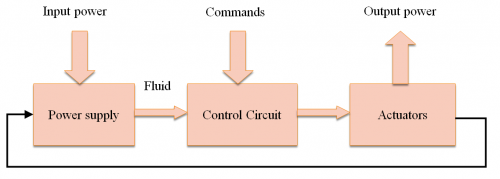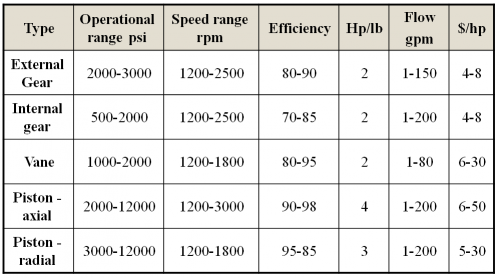Table of Contents
Hydraulics and Pneumatics
Hydraulics and Pneumatics are two types of actuators that convert the fluid pressure into mechanical motion. Although their application is different they are bough under the same section as they work under the same principles and have similar configurations
Introduction
Both hydraulics and pneumatics work based on the pascal law that says “pressure exerted anywhere in a confined incompressible fluid is transmitted equally in all directions throughout the fluid such that the pressure ratio (initial difference) remains the same.” 1)The below figure shows the general scheme of any hydraulic or pneumatic system.
Components
Power Supply
The working fluid for the hydraulic systems is a liquid (normally oil or a mixture of water and some other material)whereas Pneumatics uses air as the working fluid. In this regard the hydraulic systems have a reservoir and the liquid always gets back to the reservoir after operation while in pneumatic systems air is usually exhausted to the atmosphere at the end of the operation. A hydraulic power supply consists of a reservoir, a pump, a motor to actuate the pump (electric, diesel, etc) and conditioning units such as coolers or filters. This power supply can be bough ready to use as a power pack or be made by combining its different components. The pumps of the hydraulic systems are positive displacement meaning that their flow is proportional to the RPM of their input shaft, regardless of the load (pressure). There are different types of hydraulic pumps that can be selected based on the required pressure and other criteria mentioned below
The Pneumatic power supply is called a compressor. As opposed to the hydraulic systems, a pneumatic power supply has a (almost)constant pressure with variable flow. Usually the compressors have an FRL (filter regulator lubricator) unit included. the pressure of pneumatic systems does not exceed 150 psi most of the time.
Control System
In Hydraulic and Pneumatic systems any component other than the actuators and the power supply are considered to be part of the control systems. Based on the application, we can either decide to do a fully hydraulic (pneumatic) control which means using the fluid force to actuate the valves, or a separate electrical control circuit. Examples of these two control schemes are shown below.
Actuators
Generally speaking the hydraulic and pneumatic actuators can be divided into linear and rotary actuators. Also linear actuators can be broken down to single act and double act cylinders meaning whether they have fluid actuating force for both directions or they will just return with gravity or spring force. single act actuators are more common in Pneumatic systems rather than the hydraulic ones. There are some more specific linear actuators among which telescopic cylinders and air slides are the most common ones. Telescopic cylinders are the best solutions when is long stroke is needed in a place where there is not much room for a lengthy actuator. Air slides are a combination of a pneumatic cylinder and a linear guide which is also equipped with some sensors such as proximity switches.
Application
Hydraulics and Pneumatics have been vastly used in heavy industry (more specifically). Forestry, automotive, sheet metal rolling and pressing are samples of these applications. Pneumatics has also applications in smaller size and more precise devices such as dental hand-pieces. The biggest problem with using these systems is their initial cost as they need so many accessories including the power supply. The actuators themselves are also expensive although it would be much more expensive to get the same amount of power out of electric systems for most of the cases. As a rule of thumb a basic pneumatic system would cost minimum $200-$300 and a hydraulic system won't be cheaper than $800-$1000. Due to these drawbacks these systems are not much used for musical applications. The below figure shows one of the limited applications which is a virtual violin player that uses pneumatic force to actuate the fingering.
Summary
In summary the advantages and disadvantages of the hydraulic systems are:
Hydraulic systems
Advantages
- No problem with misalignment which is the case for mechanical systems
- Compact and strong with no to gearbox for speed reduction
- No wear – no rusting as everything is being lubricated constantly
- Easy to handle shock loads with a built in damper
- The need/generate no magnetic field or spark as is the case for electrical systems
- They have relatively quiet operation, although the power supply is noisy
Disadvantages
- Relatively low accuracy (compared to electrical systems with speed reduction)
- Need to power pack and hosing
- Relatively slow
- Expensive and needs too many accessories
Pneumatic systems
Advantages
- The working fluid is air which is cheap and does not need a reservoir
- Clean
- Relatively fast
- Easy to control the force (suitable for force feedback)
- The need/generate no magnetic field or spark as is the case for electrical systems
- Easy to handle shock loads with a built in damper
Disadvantages
- No control on the position
- A bit noise, specially the compressor
- Has too many accessories
Suppliers
The most well-known suppliers of hydraulic and pneumatic systems are Parker http://www.parker.com and bosch-rexroth http://www.boschrexroth.com Also
SMC http://www.smcpneumatics.com is relatively well-known for its pneumatic products.





